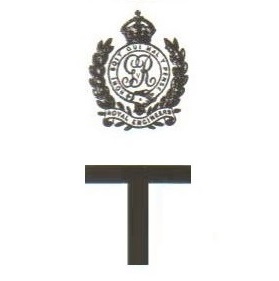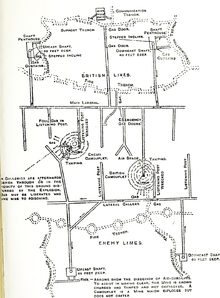
Royal Engineer tunnelling companies were specialist units of the Corps of Royal Engineers within the British Army formed to dig attacking tunnels under enemy lines during the First World War.

The Hohenzollern Redoubt action, 2–18 March 1916 was fought on the Western Front during the First World War. The Hohenzollern Redoubt was a German defensive position north of Loos-en-Gohelle (Loos), a mining town north-west of Lens in France. The Redoubt was fought over by the British and German armies from the Battle of Loos to the beginning of the Battle of the Somme on 1 July 1916. Over the winter of 1915–1916, the 170th Tunnelling Company RE dug several galleries under the German lines in the area of the redoubt, which had changed hands several times since September 1915. In March 1916, the west side was held by the British and the east side was occupied by the Germans, with the front near a new German trench known as The Chord. No man's land had become a crater field and the Germans had an unobstructed view of the British positions from the Fosse 8 slag heap. The British front line was held by outposts to reduce the number of troops vulnerable to mine explosions and the strain of knowing that the ground could erupt at any moment.

The 175th Tunnelling Company was one of the tunnelling companies of the Royal Engineers created by the British Army during World War I. The tunnelling units were occupied in offensive and defensive mining involving the placing and maintaining of mines under enemy lines, as well as other underground work such as the construction of deep dugouts for troop accommodation, the digging of subways, saps, cable trenches and underground chambers for signals and medical services.

The 170th Tunnelling Company was one of the tunnelling companies of the Royal Engineers created by the British Army during World War I. The tunnelling units were occupied in offensive and defensive mining involving the placing and maintaining of mines under enemy lines, as well as other underground work such as the construction of deep dugouts for troop accommodation, the digging of subways, saps, cable trenches and underground chambers for signals and medical services.

The Hohenzollern Redoubt was a strongpoint of the German 6th Army on the Western Front during the First World War, at Auchy-les-Mines near Loos-en-Gohelle in the Nord-Pas-de-Calais region of France. Named after the House of Hohenzollern, the redoubt was fought for by German and British forces. Engagements took place from the Battle of Loos (25 September – 14 October 1915) to the beginning of the Battle of the Somme on 1 July 1916, including the action of the Hohenzollern Redoubt in 1915 and the British Attack at the Hohenzollern Redoubt from 2 to 18 March 1916.

The 176th Tunnelling Company was one of the tunnelling companies of the Royal Engineers created by the British Army during World War I. The tunnelling units were occupied in offensive and defensive mining involving the placing and maintaining of mines under enemy lines, as well as other underground work such as the construction of deep dugouts for troop accommodation, the digging of subways, saps, cable trenches and underground chambers for signals and medical services.

The 172nd Tunnelling Company was one of the tunnelling companies of the Royal Engineers created by the British Army during World War I. The tunnelling units were occupied in offensive and defensive mining involving the placing and maintaining of mines under enemy lines, as well as other underground work such as the construction of deep dugouts for troop accommodation, the digging of subways, saps, cable trenches and underground chambers for signals and medical services.

The 174th Tunnelling Company was one of the tunnelling companies of the Royal Engineers created by the British Army during World War I. The tunnelling units were occupied in offensive and defensive mining involving the placing and maintaining of mines under enemy lines, as well as other underground work such as the construction of deep dugouts for troop accommodation, the digging of subways, saps, cable trenches and underground chambers for signals and medical services.

The 173rd Tunnelling Company was one of the tunnelling companies of the Royal Engineers created by the British Army during World War I. The tunnelling units were occupied in offensive and defensive mining involving the placing and maintaining of mines under enemy lines, as well as other underground work such as the construction of deep dugouts for troop accommodation, the digging of subways, saps, cable trenches and underground chambers for signals and medical services. On 17 April 1915, 173rd Tunnelling Company became the first Royal Engineer tunnelling company to fire mines beneath enemy lines.

The 178th Tunnelling Company was one of the tunnelling companies of the Royal Engineers created by the British Army during World War I. The tunnelling units were occupied in offensive and defensive mining involving the placing and maintaining of mines under enemy lines, as well as other underground work such as the construction of deep dugouts for troop accommodation, the digging of subways, saps, cable trenches and underground chambers for signals and medical services.

The 179 Tunnelling Company was one of the tunnelling companies of the Royal Engineers created by the British Army during World War I. The tunnelling units were occupied in offensive and defensive mining involving the placing and maintaining of mines under enemy lines, as well as other underground work such as the construction of deep dugouts for troop accommodation, the digging of subways, saps, cable trenches and underground chambers for signals and medical services. 179th Tunnelling Company is particularly known for its role at L'îlot de La Boisselle and for firing the Lochnagar mine during the Battle of the Somme 1916. The Lochnagar mine formed part of a series of 19 mines that were placed beneath the German lines on the British section of the Somme front to assist the start of the battle.

The 183rd Tunnelling Company was one of the tunnelling companies of the Royal Engineers created by the British Army during World War I. The tunnelling units were occupied in offensive and defensive mining involving the placing and maintaining of mines under enemy lines, as well as other underground work such as the construction of deep dugouts for troop accommodation, the digging of subways, saps, cable trenches and underground chambers for signals and medical services.

The 182nd Tunnelling Company was one of the tunnelling companies of the Royal Engineers created by the British Army during World War I. The tunnelling units were occupied in offensive and defensive mining involving the placing and maintaining of mines under enemy lines, as well as other underground work such as the construction of deep dugouts for troop accommodation, the digging of subways, saps, cable trenches and underground chambers for signals and medical services.

The 184th Tunnelling Company was one of the tunnelling companies of the Royal Engineers created by the British Army during World War I. The tunnelling units were occupied in offensive and defensive mining involving the placing and maintaining of mines under enemy lines, as well as other underground work such as the construction of deep dugouts for troop accommodation, the digging of subways, saps, cable trenches and underground chambers for signals and medical services.

The 185th Tunnelling Company was one of the tunnelling companies of the Royal Engineers created by the British Army during World War I. The tunnelling units were occupied in offensive and defensive mining involving the placing and maintaining of mines under enemy lines, as well as other underground work such as the construction of deep dugouts for troop accommodation, the digging of subways, saps, cable trenches and underground chambers for signals and medical services.

The 251st Tunnelling Company was one of the tunnelling companies of the Royal Engineers created by the British Army during World War I. The tunnelling units were occupied in offensive and defensive mining involving the placing and maintaining of mines under enemy lines, as well as other underground work such as the construction of deep dugouts for troop accommodation, the digging of subways, saps, cable trenches and underground chambers for signals and medical services. On Friday, 10 August 1917, 251st Tunnelling Company fired the last British mine of World War I.

The 252nd Tunnelling Company was one of the tunnelling companies of the Royal Engineers created by the British Army during World War I. The tunnelling units were occupied in offensive and defensive mining involving the placing and maintaining of mines under enemy lines, as well as other underground work such as the construction of deep dugouts for troop accommodation, the digging of subways, saps, cable trenches and underground chambers for signals and medical services. 252nd Tunnelling Company is particularly known for creating the Hawthorn Ridge mine during the Battle of the Somme 1916, which formed part of a series of mines that were placed beneath the German lines.

The 3rd Canadian Tunnelling Company was one of the tunnelling companies of the Canadian Military Engineers during World War I. The tunnelling units were occupied in offensive and defensive mining involving the placing and maintaining of mines under enemy lines, as well as other underground work such as the construction of deep dugouts for troop accommodation, the digging of subways, saps, cable trenches and underground chambers for signals and medical services.

The 2nd Canadian Tunnelling Company was one of the tunnelling companies of the Canadian Military Engineers during World War I. The tunnelling units were occupied in offensive and defensive mining involving the placing and maintaining of mines under enemy lines, as well as other underground work such as the construction of deep dugouts for troop accommodation, the digging of subways, saps, cable trenches and underground chambers for signals and medical services.

The 1st Canadian Tunnelling Company was one of the tunnelling companies of the Canadian Military Engineers during World War I. The tunnelling units were occupied in offensive and defensive mining involving the placing and maintaining of mines under enemy lines, as well as other underground work such as the construction of deep dugouts for troop accommodation, the digging of subways, saps, cable trenches and underground chambers for signals and medical services.





